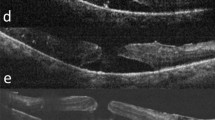Abstract
The aim of this study was to characterise different etiologies for the development of macular holes in diabetic retinopathy. We examined 8 eyes of 8 patients with known diabetic retinopathy who had developed a macular hole. These were classified as follows: related to macular edema (4 eyes), non-related to macular edema (2 eyes), intraoperative (1 eye) or postoperative (1 eye) after pars plana vitrectomy for proliferative diabetic retinopathy. In three patients the macular holes were treated with pars plana vitrectomy and fluid air exchange.
In diabetic eyes with macular edema, macular holes may develop because of intraretinal exudation combined with increased vitreomacular attachments and tractions. The mechanism of macular hole formation in diabetic eyes without macular edema probably results from the same increased tangential vitreous traction which is seen in idiopathic age-related macular holes. Iatrogenically induced macular holes during pars plana vitrectomy for proliferative diabetic retinopathy may be also due to intraoperative vitreoretinal tugging. Finally, macular holes developing after vitrectomy may have an etiology not related to vitreous tractions or attachments.
Similar content being viewed by others
References
Johnson RN, Gass JDM. Idiopathic macular holes: observations, stages of formation and implications of surgical intervention. Ophthalmology 1998; 95: 917-24.
Gass JDM. Reappraisal of biomicroscopic classification of stages of development of a macular hole. Am J Ophthalmol 1995; 119: 752-9.
Kelly NE, Wendel RT. Vitreous surgery for idiopathic macular holes. Results of a pilot study. Arch Ophthalmol 1991; 109: 654-9.
Kim JW, Freeman WR, Azen SP, El-Haig W, Klein DJ, Bailey IL. Prospective randomized trial of vitrectomy or observation for stage 2 macular holes. Vitrectomy for Macular Hole Study Group. Am J Ophthalmol 1996; 121: 605-14.
Freeman WR, Azen SP, Kim JW, El-Haig W, Mishel DR, Baiely I. Vitrectomy for the treatment of full-thickness stage 3 or 4 macular holes. Results of a multicenter randomized clinical trial. Arch Ophthalmol 1997; 115: 11-21.
Gass JDM. Stereoscopic Atlas of Macular Diseases: Diagnosis and Treatment, 3rd ed. St. Louis: C.V. Mosby, 1987; 170, 552-65.
Campo RV, Lewis RS. Lightning-induced macular hole. Am J Ophthalmol 1984; 97: 792-4.
Munoz FJ, Rebolleda G, Cores FJ, Bertrand J. Congenital retinal arteriovenous communication associated with a full-thickness macular hole. Acta Ophthalmol (Copenh) 1991; 69: 117-20.
Cohen SM, Gass JDM. Macular hole following severe hypertensive retinopathy. Am J Ophthalmol 1994; 112: 878-9.
Flynn HW. Macular hole surgery in patients with proliferative diabetic retinopathy. Am J Ophthalmol 1994; 112: 877-8.
Aaberg TM. Macular holes: a review. Surv Ophthalmol 1970; 15: 139-62.
Yanoff M, Fine BS. Ocular pathology. A text and atlas, 2nd ed. Philadelphia: Harper and Row, Publishers, Inc, 1982; 726-30.
Foos RY. Vitreoretinal juncture: topographical variations. Invest Ophthalmol Vis Sci 1972; 11: 801-8.
Tsujikawa M, Saito Y, Lewis JM, Tano Y. Secondary vitrectomy for the treatment of macular holes occurring after vitrectomy. Ophthalmic Surg Lasers 1997; 28: 336-7.
Garcia-Arumi J, Corcostegui B, Cavero L, Sarasols L. The role of vitreoretinal surgery in the treatment of posttraumatic macular hole. Retina 1997; 17: 372-7.
Author information
Authors and Affiliations
Rights and permissions
About this article
Cite this article
Brazitikos, P.D., Stangos, N.T. Macular hole formation in diabetic retinopathy: the role of coexisting macular edema. Doc Ophthalmol 97, 273–278 (1999). https://doi.org/10.1023/A:1002117602501
Issue Date:
DOI: https://doi.org/10.1023/A:1002117602501




